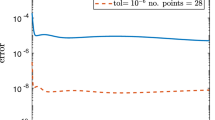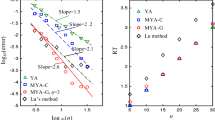Abstract
A unified fast time-stepping method for both fractional integral and derivative operators is proposed. The fractional operator is decomposed into a local part with memory length \(\varDelta T\) and a history part, where the local part is approximated by the direct convolution method and the history part is approximated by a fast memory-saving method. The fast method has \(O(n_0+\sum _{\ell }^L{q}_{\alpha }(N_{\ell }))\) active memory and \(O(n_0n_T+ (n_T-n_0)\sum _{\ell }^L{q}_{\alpha }(N_{\ell }))\) operations, where \(L=\log (n_T-n_0)\), \(n_0={\varDelta T}/\tau ,n_T=T/\tau \), \(\tau \) is the stepsize, T is the final time, and \({q}_{\alpha }{(N_{\ell })}\) is the number of quadrature points used in the truncated Laguerre–Gauss (LG) quadrature. The error bound of the present fast method is analyzed. It is shown that the error from the truncated LG quadrature is independent of the stepsize, and can be made arbitrarily small by choosing suitable parameters that are given explicitly. Numerical examples are presented to verify the effectiveness of the current fast method.








Similar content being viewed by others
References
Baffet, D., Hesthaven, J.S.: High-order accurate adaptive kernel compression time-stepping schemes for fractional differential equations. J. Sci. Comput. 72(3), 1169–1195 (2017)
Baffet, D., Hesthaven, J.S.: A kernel compression scheme for fractional differential equations. SIAM J. Numer. Anal. 55(2), 496–520 (2017)
Banjai, L., López-Fernández, M., Schädle, A.: Fast and oblivious algorithms for dissipative and two-dimensional wave equations. SIAM J. Numer. Anal. 55(2), 621–639 (2017)
Beylkin, G., Monzn, L.: Approximation by exponential sums revisited. Appl. Comput. Harmon. Anal. 28(2), 131–149 (2010)
D’Amore, L., Murli, A., Rizzardi, M.: An extension of the Henrici formula for Laplace transform inversion. Inverse Probl. 16(5), 1441–1456 (2000)
Deng, W.: Short memory principle and a predictor–corrector approach for fractional differential equations. J. Comput. Appl. Math. 206(1), 174–188 (2007)
Diethelm, K.: Generalized compound quadrature formulae for finite-part integrals. IMA J. Numer. Anal. 17(3), 479–493 (1997)
Diethelm, K.: The Analysis of Fractional Differential Equations. Springer, Berlin (2010)
Diethelm, K., Ford, J.M., Ford, N.J., Weilbeer, M.: Pitfalls in fast numerical solvers for fractional differential equations. J. Comput. Appl. Math. 186(2), 482–503 (2006)
Ford, N.J., Simpson, A.C.: The numerical solution of fractional differential equations: speed versus accuracy. Numer. Algorithms 26(4), 333–346 (2001)
Galeone, L., Garrappa, R.: Fractional Adams–Moulton methods. Math. Comput. Simul. 79(4), 1358–1367 (2008)
Gatteschi, L.: Asymptotics and bounds for the zeros of laguerre polynomials: a survey. J. Comput. Appl. Math. 144(1), 7–27 (2002)
Jiang, H., Liu, F., Turner, I., Burrage, K.: Analytical solutions for the multi-term time-fractional diffusion-wave/diffusion equations in a finite domain. Comput. Math. Appl. 64(10), 3377–3388 (2012)
Jiang, S., Zhang, J., Zhang, Q., Zhang, Z.: Fast evaluation of the Caputo fractional derivative and its applications to fractional diffusion equations. Commun. Comput. Phys. 21(3), 650–678 (2017)
Jin, B., Lazarov, R., Zhou, Z.: An analysis of the L1 scheme for the subdiffusion equation with nonsmooth data. IMA J. Numer. Anal. 36(1), 197–221 (2016)
Li, C., Yi, Q., Chen, A.: Finite difference methods with non-uniform meshes for nonlinear fractional differential equations. J. Comput. Phys. 316, 614–631 (2016)
Li, C., Zeng, F.: Numerical Methods for Fractional Calculus. Chapman & Hall/CRC Numerical Analysis and Scientific Computing. CRC Press, Boca Raton (2015)
Li, J.R.: A fast time stepping method for evaluating fractional integrals. SIAM J. Sci. Comput. 31(6), 4696–4714 (2010)
Li, Z., Liang, Z., Yan, Y.: High-order numerical methods for solving time fractional partial differential equations. J. Sci. Comput. 71(2), 785–803 (2017)
López-Fernández, M., Lubich, C., Schädle, A.: Adaptive, fast, and oblivious convolution in evolution equations with memory. SIAM J. Sci. Comput. 30(2), 1015–1037 (2008)
Lubich, C.: Discretized fractional calculus. SIAM J. Math. Anal. 17(3), 704–719 (1986)
Lubich, C., Schädle, A.: Fast convolution for nonreflecting boundary conditions. SIAM J. Sci. Comput. 24(1), 161–182 (2002)
Luchko, Y.: Initial-boundary problems for the generalized multi-term time-fractional diffusion equation. J. Math. Anal. Appl. 374(2), 538–548 (2011)
Lv, C., Xu, C.: Error analysis of a high order method for time-fractional diffusion equations. SIAM J. Sci. Comput. 38(5), A2699–A2724 (2016)
Mastroianni, G., Monegato, G.: Truncated quadrature rules over \((0,\infty )\) and Nyström-type methods. SIAM J. Numer. Anal. 41, 1870–1892 (2006)
Mastroianni, G., Monegato, G.: Some new applications of truncated Gauss–Laguerre quadrature formulas. Numer. Algorithms 49, 283–297 (2008)
McLean, W.: Fast summation by interval clustering for an evolution equation with memory. SIAM J. Sci. Comput. 34(6), A3039–A3056 (2012)
McLean, W.: Exponential sum approximations for \(t^{-\beta }\) p. arXiv:1606.00123 (2016)
McLean, W., Mustapha, K.: A second-order accurate numerical method for a fractional wave equation. Numer. Math. 105(3), 481–510 (2007)
Metzler, R., Klafter, J.: The random walk’s guide to anomalous diffusion: a fractional dynamics approach. Phys. Rep. 339(1), 77 (2000)
Podlubny, I.: Fractional differential equations. Academic Press Inc, San Diego (1999)
Samko, S.G., Kilbas, A.A., Marichev, O.I.: Fractional Integrals and Derivatives: Theory and Applications. Gordon and Breach Science Publishers, Yverdon (1993)
Schädle, A., López-Fernández, M., Lubich, C.: Fast and oblivious convolution quadrature. SIAM J. Sci. Comput. 28(2), 421–438 (2006)
Shen, J., Tang, T., Wang, L.L.: Spectral Methods, Springer Series in Computational Mathematics, vol. 41. Springer, Heidelberg (2011)
Stynes, M., O’Riordan, E., Gracia, J.L.: Error analysis of a finite difference method on graded meshes for a time-fractional diffusion equation. SIAM J. Numer. Anal. 55(2), 1057–1079 (2017)
Sun, Zz, Wu, X.: A fully discrete difference scheme for a diffusion-wave system. Appl. Numer. Math 56(2), 193–209 (2006)
Wang, C.L., Wang, Z.Q., Jia, H.L.: An hp-version spectral collocation method for nonlinear Volterra integro-differential equation with weakly singular kernels. J. Sci. Comput. 72, 647–678 (2017)
Wang, D., Xiao, A.: Dissipativity and contractivity for fractional-order systems. Nonlinear Dyn. 80(1), 287–294 (2015)
Weideman, J.A.C.: Optimizing talbots contours for the inversion of the laplace transform. SIAM J. Numer. Anal. 44(6), 2342–2362 (2006)
Weideman, J.A.C., Trefethen, L.N.: Parabolic and hyperbolic contours for computing the Bromwich integral. Math. Comput. 76(259), 1341–1356 (2007)
Xiang, S.: Asymptotics on Laguerre or Hermite polynomial expansions and their applications in Gauss quadrature. J. Math. Anal. Appl. 393(2), 434–444 (2012)
Yan, Y., Sun, Z.Z., Zhang, J.: Fast evaluation of the caputo fractional derivative and its applications to fractional diffusion equations: a second-order scheme. Commun. Comput. Phys. 22(4), 1028–1048 (2017)
Yu, Y., Perdikaris, P., Karniadakis, G.E.: Fractional modeling of viscoelasticity in 3D cerebral arteries and aneurysms. J. Comput. Phys. 323, 219–242 (2016)
Zayernouri, M., Matzavinos, A.: Fractional Adams-Bashforth/Moulton methods: an application to the fractional Keller–Segel chemotaxis system. J. Comput. Phys. 317, 1–14 (2016)
Zeng, F., Zhang, Z., Karniadakis, G.E.: Fast difference schemes for solving high-dimensional time-fractional subdiffusion equations. J. Comput. Phys. 307, 15–33 (2016)
Zeng, F., Zhang, Z., Karniadakis, G.E.: Second-order numerical methods for multi-term fractional differential equations: smooth and non-smooth solutions. Comput. Methods Appl. Mech. Eng. 327, 478–502 (2017)
Acknowledgements
The authors are very grateful to the anonymous referees for the careful reading of a preliminary version of the manuscript and their valuable suggestions and comments, which greatly improve the quality of this paper.
Author information
Authors and Affiliations
Corresponding author
Additional information
This work was supported by ARC Discovery Project DP150103675.
Proofs
Proofs
1.1 Proof of Theorem 1.
Proof
We follow the proof of Theorem 2.2 in [41]. We first expand \(g(\lambda )=e^{-t\lambda }\) in terms of the Laguerre polynomials, i.e., \(g(\lambda )=\sum _{n=0}^{\infty }a_nL_n^{(\alpha )}(\lambda ),\) where
The following property will be used, see [41],
With the above two equations and \(J^{\alpha }[e^{-t\lambda }]- Q_N^{\alpha }[e^{-t\lambda }] =\sum _{n=2N}^{\infty }a_nQ_N^{\alpha }[L_n^{(\alpha )}]\) gives
Let \(q=t/(1+t)\). Then we have \(\sum _{n=2N}^{\infty }a_n=(1+t)^{-\alpha }q^{2N}\) for \(-1<\alpha \le 0\). For \(\alpha >0\), one has
where \(C_{\alpha ,t} =\sum _{n=0}^{\infty }(n+2)^{\alpha }q^{2Nn}\) is used. With the above equation and (54) yields (42) for \(T=1\). Using the following relation
leads to (42) for any \(T>0\). The proof is complete. \(\square \)
1.2 Proof of Theorem 2.
Proof
The following results can be found in [12],
where (56) holds when j is sufficiently large. For a sufficiently large N, the Laguerre polynomial satisfies (see (7.14) in [34])
With (55)–(57) and (41), we have the following estimate
for sufficiently large j, where \({\lambda }_j=\theta _j(j+1)^2/(N+1)\) and \(\theta _j\) is bounded and approximately between \(\pi ^2/4\) and 4. The proof is completed. \(\square \)
1.3 Proof of Theorem 3.
Proof
For notational simplicity, we denote
Next, we investigate how to estimate \(N_{\ell }\) in (35), such that the LG quadrature \(Q_{N_{\ell }}^{-\alpha }[\widehat{T}_{\ell },e^{-\widehat{H}^n_{\ell }(s)\lambda }]\) to the integral \(J^{-\alpha }[\widehat{T}_{\ell },e^{-\widehat{H}^n_{\ell }(s)\lambda }]\) preserves the accuracy up to \(O(\epsilon )\) for all \(s\in [s_{\ell },s_{\ell -1}]\).
From Theorem 1, we know that the error of \(Q_{N_{\ell }}^{-\alpha }[\widehat{T}_{\ell },e^{-\widehat{H}^n_{\ell }(s)\lambda }]\) mainly depends on the following term
Using (34) and \(T_{\ell -1}=B^{\ell -1}\tau \) gives
Using the above inequality and Eq. (42) yields
Since the relative error of (60) is independent of \(\widehat{T}_{\ell }\), we can let \((\mathcal {T}_{\ell }/(\mathcal {T}_{\ell }+1))^{2N_{\ell }}\le \epsilon \), which yields the minimum \(N_{\ell }\) given by (36).
From (44) and (60), we derive that the pointwise error of the truncated quadrature \(Q_{N_{\ell },\epsilon _0}^{-\alpha }[\widehat{T}_{\ell },e^{-\widehat{H}^n_{\ell }(s)\lambda }]\) for all \(s\in [s_{\ell },s_{\ell -1}]\) is given by
where \(Q_{N_{\ell },\epsilon _0}^{-\alpha }\) is defined by (44) and \(N_{\ell }\) is given by (36).
The proof is complete. \(\square \)
Rights and permissions
About this article
Cite this article
Zeng, F., Turner, I. & Burrage, K. A Stable Fast Time-Stepping Method for Fractional Integral and Derivative Operators. J Sci Comput 77, 283–307 (2018). https://doi.org/10.1007/s10915-018-0707-9
Received:
Revised:
Accepted:
Published:
Issue Date:
DOI: https://doi.org/10.1007/s10915-018-0707-9




